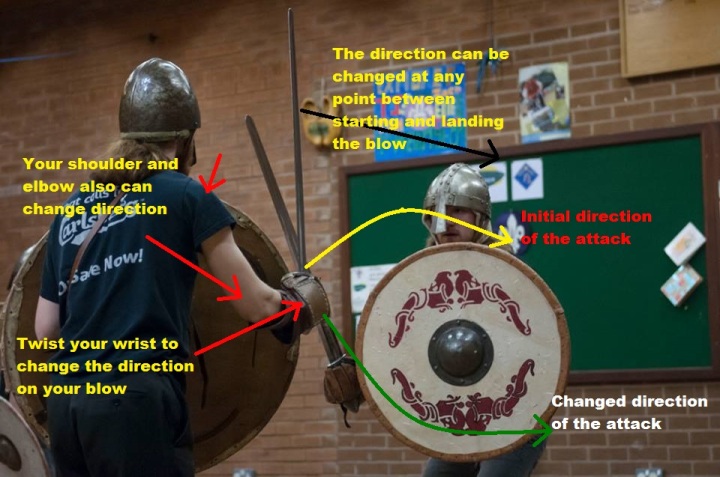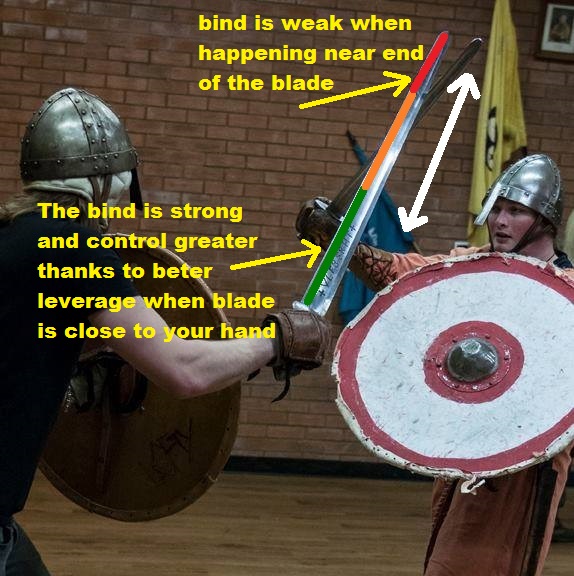After a long time without a post (life does get in the way every now and again) it is time for a new post, which will cover the most glorified weapon of them all: the sword.

The sword was a weapon pure and simple, with no other utility. It’s purpose- to kill. It was an equivalent of a quality car back in the Dark Ages, and only the rich and the professionals could afford one. Swords were beautiful, efficient and glorious tools of slaughter. But how does one use a sword in reenactment combat?
“Hit them!” some might say- well, they are not far off… But sword is more sophisticated to use than any other weapons and allows a wide variety of techniques, most of which other weapons have great trouble duplicating. In this article, I will cover the basics of Dark Age swordsmanship, to give you pointers on how to get familiar with it, and what to avoid, when waiving your shiny piece of steel about.

1. The principles
A Viking Age sword is a hacking weapon, first and foremost. It’s weight, balance, size and breadth all speak volumes about how it was used. This is not a fencing sword, or a rapier. You must keep this in mind when using the sword, as it will be rather different from swords from later periods, or indeed earlier ones. A sword must be held firmly, but gently, to allow flexibility of movement. Use hacking, rather than thrusting- and not just for practical reasons, but also for safety. A thrust carries a lot more force than a cut, therefore there is a greater potential for injury, especially with a naturally heavier blade.

When attacking, same principles apply as with other weapons: eight areas of attack, and eight of defence. Blows to the head are forbidden in our combat system, but we teach how to defend against them just in case.

A sword is different from other weapons in the fact, that it can be very effectively used as a defensive weapon, and is therefore better suited for less aggressive warriors. But, it can equally well serve as purely offensive weapon, and with (usually) double-edged blade, and between 30 to 40 inches of killing edge, there is a lot more you can do, than say with an axe, which can only “kill” with a short blade on it’s head.
When striking, a warrior uses the edge, not the point of the blade, and always pulls the blow to the body, to prevent injury.
2. The techniques, the tricks and some advice:
When using a sword, it is a lot easier to make feints and change direction of an attack, due to different balance of the weapon. Look the example below:

A warrior can rapidly change direction and speed of an attack, thanks to more evenly spread balance. Sword point can travel a large distance with just a small move of a hand, at great speed, with less effort than a spear or an axe would usually require.
Cross guard of a sword is very useful in taking control of enemy’s weapons and performing circular parries. When in a bind, the closer the bind point is to the cross guard, the more control you have over it, thanks to better leverage. This is known as “strong” or “weak” bind, whereas “weak” bind means you have very little control over it, and must apply a lot of force, to force leverage, as oppose to a situation, when you can control the bind with little effort.

Thanks to principles of “strong” and “weak” bind, a sword can be used to create openings in the opponent’s defence. In this photo, a combatant uses a bind to move opponent’s weapon out of the way, and then to attack as soon as a space becomes available.
In defence, a sword can parry effectively and hold a blow well, while being better at swift counter attacks, than most other weapons.

Sword is great at medium-range, but becomes a lot less useful in close quarters. Be aware of it, and be prepared to either retreat from an advancing opponent, or deter them from advancing by putting up appropriate response, for example a series of attacks, or a side-step, or a dogged, unflinching defensive stance.
Using a shield in tandem with a sword is a great way to exploit openings in your opponent’s defence. Remember the active shield work, I have talked about in my other articles? How would you use a shield to take control of an enemy’s weapon? Can you use it to attack? Can you follow the enemy’s weapon and keep it in touch with your shield to make any attacks very hard to perform?

Footwork, like with any other weapon, is key. If your feet and your balance are in a wrong place, your weapon will also be. Keep your feet wide apart, in an L-shape, with knees slightly bend, and adjust your stance as you move your weight center. Practice walking, stepping and waddling, to make sure you automatically keep your balance.
You may try to change your stance as you fight, to give yourself different options, and present your opponent with different challenges. How about a low stance? Aggressive sword stance? Can your conceal the blade behind a shield, and strike out unexpectedly, where the enemy cannot see the initial direction of the blow?

When holding sword underneath the shield, you give yourself great way of striking at opponent’s legs and lower torso, or “sneaking” a blow under the shield. Trade off- vulnerable to being overrun, by a fast and decisive warrior, with little room to move the sword out of the way.

Holding a shield at an angle, rather than straight on enables better active shieldwork, and puts more distance between warriors- but what about leaving sword arm more vulnerable, than it would normally be? How much extra effort would need to be put in, to parry incoming blows with a sword, rather than shield? Is the advantage of having two “tools” to use in a fight big enough?

3. A few words to sum it up:
The stuff I have talked about above, are just some more general and basic techniques, for using a sword using a sword. There are a lot of more advanced tricks and techniques, which will be explored later, in more detail.
Sword is an amazing weapon to use, and it is iconic, just as the axe is, for the Viking Age. It requires plenty of practice, but it is so worth it! If you haven’t had a go at a sword yet, try it out, and use the examples I gave above. And if you already are a swordsman, what would you add and how do you keep your opponents on their toes?
Until next time folks!
